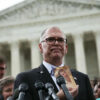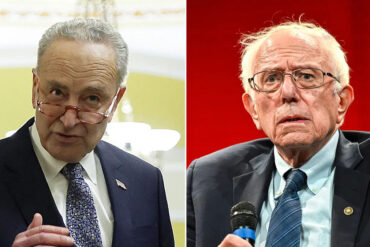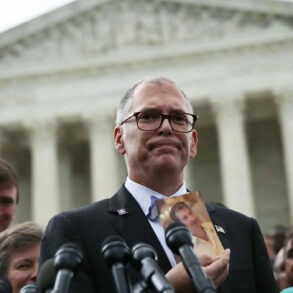After nearly 41 days of a shutdown, the Senate voted 60 to 40 to invoke cloture and defeat a Democratic filibuster on a funding package to reopen the government. The 60th vote arrived late Sunday night when Sen. John Cornyn reached the Capitol after travel delays linked to the shutdown’s strain on air traffic control. Members in the chamber cheered when the tally hit 60. One Republican, Sen. Rand Paul, opposed the measure. Eight members of the Democratic caucus crossed over: Sens. Dick Durbin, Tim Kaine, Jeanne Shaheen, Maggie Hassan, Catherine Cortez Masto, Jacky Rosen, John Fetterman, and Independent Angus King, who caucuses with Democrats. Final passage must still occur, but breaking the filibuster cleared the key hurdle.
Sen. Angus King explained why he switched paths. “After six weeks — going on seven weeks — that path wasn’t working,” he said, arguing that continuing the shutdown would not force Republicans to extend health care tax credits. “There’s no evidence that it would.”
What the two sides agreed to in the deal
The agreement would reopen the federal government through January 30, 2026. It also advances a three bill minibus to fund the legislative branch, military construction and Veterans Affairs, and the Department of Agriculture for the full fiscal year. Democrats who backed the package secured language that prevents mass layoffs of federal workers through January 30 and guarantees back pay for federal employees fired during the shutdown. They also obtained a stand alone vote in December on extending Affordable Care Act subsidies.
Republicans kept the package free of an immediate subsidy extension. President Donald Trump underscored the GOP stance on broader benefit policy, saying, “We’ll never agree to give any substantial money, or any money to really prisoners, illegals, to come into our country, and I think the Democrats understand that.”
Damage on the ground
The shutdown began on October 1 when Democrats rejected a short term House funding bill that would have kept the government open until November 21. Democrats insisted Congress first address expiring ACA subsidies and reverse cuts to Medicaid included in the One Big Beautiful Bill Act. Republicans said those cuts targeted waste, fraud, and abuse and refused to negotiate health policy during a shutdown. Weeks of failed Senate votes followed until Sunday’s bipartisan breakthrough.
Air travel has suffered widespread delays and staffing shortages. The union for air traffic controllers warned that fatigue and financial stress are eroding safety. Union president Nick Daniels said controllers “have continued to show up during the shutdown” and “deserve to be recognized for what’s going on.” Staffing problems were reported at major facilities from Dallas to Chicago, Phoenix, and Las Vegas. Travelers faced ground stops and long waits. SNAP benefits were caught in fast moving court fights. An appeals court backed full payments, while a temporary Supreme Court order allowed reduced payments for several days. Many families remained in limbo as legal steps unfolded.
At the White House and on Capitol Hill, the political pressure increased. Trump publicly demanded that controllers “get back to work, NOW,” threatened penalties for those who did not, and said he would recommend a ten thousand dollar bonus for controllers who worked through the shutdown. Daniels replied that he would accept anything that “recognizes these hardworking men and women,” while stressing that controllers should not be used as political pawns.
The Democratic split bursts into view
The crossover votes reopened old rifts inside the party and focused anger on Senate Minority Leader Chuck Schumer. Rep. Ro Khanna said Schumer “is no longer effective and should be replaced. If you can’t lead the fight to stop healthcare premiums from skyrocketing for Americans, what will you fight for?” Progressive organizers and several elected Democrats called the agreement a capitulation. Leah Greenberg of Indivisible warned that “caving now will teach Trump and Republicans that they can win any fight simply by threatening to cause terrible harm to regular people.” California Gov. Gavin Newsom said, “America deserves better.”
Some Democrats framed the deal terms as far too thin. Sen. Tammy Baldwin said “a wink and a nod to deal with this healthcare crisis later — with no actual guarantees — is just not enough for me.” Rep. Greg Casar said “accepting nothing but a pinkie promise from Republicans isn’t a compromise — it’s capitulation.” One House Democrat fumed that Democrats “got a Bundt cake in return.”
Even Democrats who opposed the bill expressed frustration with prolonging the stalemate. Sen. Elizabeth Warren said, “I just don’t get what the point is of delaying even longer.” She added that she wanted Republicans to restore health care funding but did not want “to impose more pain on people who are hungry and who haven’t been paid.” Sen. Chris Coons pledged to vote no because of the subsidy issue but conceded, “I understand, I respect my colleagues who are saying it’s time.”
Sen. Bernie Sanders urged opposition, warning, “If this vote succeeds, over 20 million Americans are going to see at least a doubling in their premiums. For certain groups of people, it will be a tripling and a quadrupling of their premiums.”
Why eight Democratic caucus members broke ranks
Backers of the deal said the shutdown was inflicting needless harm and that the agreement created at least a path to debate health care later. King called it “a win for the American people,” saying it would “put people back to work” and “feed the hungry.” Kaine emphasized protections for federal workers, noting provisions that reverse firings and block new ones through January. Fetterman, who had consistently urged reopening, said it “should’ve never come to this,” calling the long lapse “a failure.”
Alongside the stopgap, the Senate will take up a three part appropriations package to fully fund certain areas for the year. Legislative branch operations would be covered, along with military construction and the Department of Veterans Affairs. The package also funds the Department of Agriculture, which oversees SNAP and the WIC program. Full year funding would protect those programs from lapses at least through November 2026. Senate Appropriations Chair Susan Collins pushed the package forward, saying her staff “missed an entire night’s sleep to get this package together.”
Republicans hold a 53 to 47 majority but needed 60 votes to break a filibuster. Until Sunday, repeated attempts to reopen the government failed because Democrats withheld support. The final 60 to 40 tally relied on eight Democratic caucus votes and every present Republican except Rand Paul. The last vote arrived with Cornyn’s late night dash from the airport after shutdown related flight chaos. That sequence underscored how close the margin was and how the shutdown itself complicated the effort to end it.
Pressure shifts to the House
Because the Senate package differs from the earlier House bill, the House must vote on this agreement. Speaker Mike Johnson praised the Senate movement and warned members to return on 36 hour notice. “We have to do this as quickly as possible,” he said, promising long days and long nights. He said reopening this week would let Congress get back to regular work. House Democrats signaled deep resistance. Rep. Jimmy Gomez said he is an “F NO” on the vote. Party leaders plan to huddle before the measure arrives.
Who wants Schumer out and how the backlash looks
The sharpest ouster calls came from Rep. Ro Khanna, who said Schumer “should be replaced.” The criticism argued that party leaders misplayed their leverage and failed to secure even a partial extension of the ACA subsidies. Progressive activists rallied the same theme, urging Democrats not to concede on health care. Schumer himself said he would vote no and “keep fighting,” arguing the package did not address what he called a health care crisis. Earlier in the year he had aligned with a small group on a funding vote, but this time he led the resistance and still lost members.
Supporters of the agreement say the vote stops the bleeding. King said, “The shutdown wasn’t achieving its goal, and it was at the same time hurting a lot of people.” Opponents warn that the deal trades leverage for promises. Baldwin called the assurances “not enough.” Casar said it was “capitulation.” Sanders predicted sharp premium spikes without subsidy action. Trump demanded federal workers in critical roles return and promised bonuses for those who did. The controllers’ union said recognition is welcome but stressed safety and stability over politics.
The next steps to reopen the government
- Finalize Senate passage. Senators must agree on debate time and hold the final vote on the package.
- Bring the House back. The House will reconvene on short notice to consider the Senate agreement.
- Send the bill to the president. After House passage, the bill goes to President Trump for signature.
- Hold the December vote on ACA subsidies. Senate Majority Leader John Thune committed to a stand alone vote next month.
- Advance the minibus. Full year funding for the legislative branch, VA and military construction, and USDA moves on a separate track, reducing the risk of immediate relapses in those areas.
If these steps proceed, a government restart is imminent. Air travel and SNAP operations should begin to stabilize, furloughed workers would return, and back pay would flow. The policy fight over health care will continue into December, and the political fight inside the Democratic Party is likely to continue much longer.







